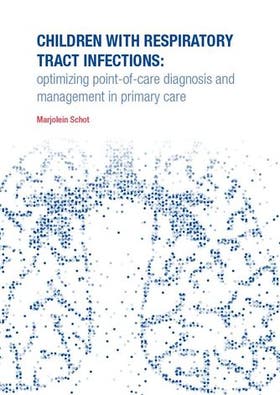Marjolein Schot
Children with respiratory tract infections: optimizing point-of-care diagnosis and management in primary care

- Datum
- (Co) promotoren
- 04-06-2019
- prof. dr. K.G.M. Moons, dr. L. Hooft, dr. C.A. Naaktgeboren
Samenvatting
Acute respiratory tract infection (RTI) are common illnesses among children. RTI are mostly self-limiting, with low risk of complications. Only a fraction of the children with RTI present to their GP. This thesis evaluates different aspects of the diagnosis and management of children with RTI in primary care. Identifying a child with pneumonia in the large group of children presenting to a GP with acute RTI is challenging for GPs. Knowledge on the diagnostic value of specific signs and symptoms may guide GPs and aid in development of future decision rules. We aimed to identify and systematically review available evidence on the diagnostic value of signs, symptoms and additional tests to diagnose pneumonia in children in an ambulatory setting in developed countries. The original search yielded 4665 records, of which 17 articles were eligible for analysis; twelve studies on signs and symptoms, four on additional laboratory tests and six on ultrasonography. All included studies were performed in a secondary care setting, where prevalence of pneumonia varied from 3.4%-71.7%. Risk of bias was present in the majority of studies in the domain of patient selection. The diagnostic value of the available 27 individual signs and symptoms to identify pneumonia was low. In a low prevalence setting (4 studies, pneumonia prevalence <10%) clinically ill appearance of the child and oxygen saturation <94% can aid a physician. In a high prevalence setting (10 studies, pneumonia >10%) additional diagnostic tests such as oxygen saturation, C-Reactive Protein and White Blood Count are more promising. Chest ultrasonography showed high diagnostic value in settings with higher prevalence of pneumonia. We concluded that single signs and symptoms from medical history and physical examination or individual additional diagnostic tests are insufficient to diagnose pneumonia in ambulant children. Unfortunately, there are very few diagnostic studies conducted in settings with low prevalence of pneumonia, and no studies from primary care could be included. We also describe the results of a cluster randomized trial which assessed whether use of point-of-care CRP by the GP reduces antibiotic prescriptions in children with suspected non-serious LRTI. 309 Children between 3 months and 12 years of age with suspected LRTI were recruited by 148 GPs: 210 children at general practices and 99 at an out-of-hours service. We found no statistically significant reduction in antibiotic prescriptions in the GP use of CRP group (30.9% vs. 39.4%; OR 0.61; 95CI 0.29-1.23). Only the estimated severity of illness was related to antibiotic prescription. Children were more likely to get an antibiotic prescription with increasing CRP level, ranging from 14% in children with a CRP level < 10 mg/L to more than 50% in children with a CRP level > 40mg/L. Point-of-care CRP levels were <10mg/L in 46% of children. Though we saw a trend towards reduction in antibiotic prescriptions, this was not statistically significant. We conclude that it is still uncertain whether using point-of-care CRP could reduce antibiotic prescribing rates in children with suspect LRTI in general practice. A future, larger study is needed to provide more robust evidence.
